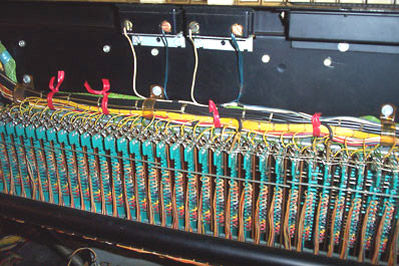X 66
North Suburban HAMMOND ORGAN Service

Figure 15. Key contact assemblies for the upper manual. The keyboard is hinged up in the service position.
After we hinge the upper manual out of the way, we get access to the key contact assemblies under the keys. This picture, figure fifteen, shows a portion of the key switches under each playing key for the upper manual. In the X, the key switches are not totally enclosed as they are in a regular Hammond. This makes key switch contact work easier, but it also leaves the key switches not as well protected from dust and dirt which are the enemies of all electronic musical instruments, especially their key contacts.
Figure sixteen is the circuit card for the most different vibrato in this instrument. This vibrato system works in a somewhat similar manner to that of the Wurlitzer 4600 series instruments in that it provides two signals that have a constant phase shift between them and selectively and gradually allows each to pass in sequence at the vibrato rate, the result of which is a continuous phase shift and resulting pitch change of the composite signal. This is similar to, but more elaborate and better than the somewhat similar system used in the Wurlitzer electrostatic instrument to provide all of their vibrato. The Hammond system provides three sets of signals approximately 180° apart.
As I mentioned in the Wurlitzer article, a vibrato of this type is more prominent on lower frequencies. In the X66 Hammond, this circuit adds vibrato to all drawbar pitches up to and including the G above Middle C. Drawbar pitches above that, however, are processed by a scanner type vibrato system somewhat similar to that of conventional Hammonds. The scanner system's performance is much better for higher frequencies. Notice, however, that this system is in some ways the electrical equivalent of a typical Leslie speaker's acoustic tremolo effect which likewise handles low and high frequencies in different systems. In the section on the X66 animation system we will explore these various vibrato systems in much greater detail.
Figure 16. Vibrato Amplifier board. Roll mouse over picture to get parts identification labels. If you're viewing this on a smart phone, tap the picture to get labels. If your computer is old and has an early version of Internet Explorer, the labeling feature will probably not function.
It's interesting to note that Hammond, in designing the X66, incorporated different types of vibrato for different tonal effects. The vibrato on the bright voices includes a much smaller pitch deviation than that for the drawbar voices, and it also includes a slight amplitude-varying tremolo in addition to the pitch vibrato. This is very close to what happens to similar voices in a pipe organ where the pitch deviation for string and some reed tones is less than that for flute and tibia voices, and where the pressure-varying pipe organ tremulant device also slightly varies the volume of these pipes.
Previous Page Page 12. Next page